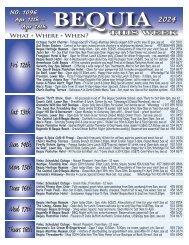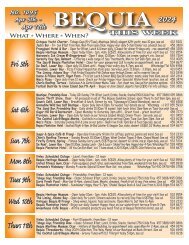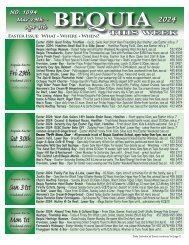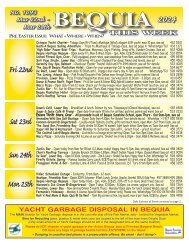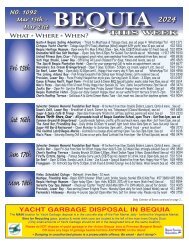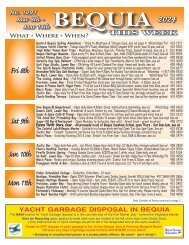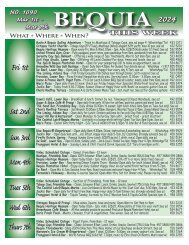Caribbean Compass Yachting Magazine - April 2022
Welcome to Caribbean Compass, the most widely-read boating publication in the Caribbean! THE MOST NEWS YOU CAN USE - feature articles on cruising destinations, regattas, environment, events...
Welcome to Caribbean Compass, the most widely-read boating publication in the Caribbean! THE MOST NEWS YOU CAN USE - feature articles on cruising destinations, regattas, environment, events...
You also want an ePaper? Increase the reach of your titles
YUMPU automatically turns print PDFs into web optimized ePapers that Google loves.
— Continued from previous page<br />
Friday, <strong>April</strong> 29th<br />
Mercury reaches its greatest eastern elongation or separation<br />
from the Sun. This is the best time to view Mercury since it<br />
will be at its highest point above the horizon in the evening<br />
sky. The bright star above or east-southeast of Mercury is<br />
Aldebaran. Halfway between these two objects asteroid 2017<br />
UK52 passes close to Earth. This is the closest approach of a<br />
known asteroid this period.<br />
Saturday, <strong>April</strong> 30th<br />
The bright object in the east this morning before dawn is the<br />
union of Jupiter and Venus. The two planets will remain very<br />
close through May 1st. In the following days, Jupiter will<br />
gradually rise higher in the sky while Venus shifts its position<br />
towards the north.<br />
The partial solar eclipse that takes place today cannot be<br />
seen in the <strong>Caribbean</strong>. It will only be visible from South<br />
America south of Bolivia into Antarctica.<br />
Monday, May 2nd<br />
A sliver Moon and Mercury have taken up position between<br />
Aldebaran and Pleiades. They all can be found low in the<br />
western sky after sunset.<br />
Friday, May 6th<br />
Earth is now passing through the remnants of comet 1P/<br />
Halley. Most of the meteors impacting Earth’s atmosphere<br />
can be seen early before sunrise. The number of meteors from<br />
the eta Aquariids shower can range from 40 to 85 per hour.<br />
They will appear to come from the line of planets in the<br />
eastern sky.<br />
A stream of meteors will radiate out of the eastern sky this<br />
evening from the constellation Libra. This constellation is<br />
located west of Scorpius. These meteors are part of the May<br />
Librids. The number of meteors from this shower is variable<br />
from year to year. It is possible to catch a glimpse of a few<br />
shooting stars from May 1st through May 9th.<br />
The Moon makes a close approach to Pollux in the evening<br />
sky. The red giant star Pollux is actually part of a multiple<br />
star system. Pollux is the bright object located north of the<br />
crescent Moon.<br />
Monday, May 9th<br />
The Moon’s gradual eastern progression places it near<br />
Regulus tonight. The Moon is one day past first quarter and<br />
bright, but you may still be able to pick out Regulus. The<br />
“Heart of the Lion” star is located south of the Moon.<br />
Friday, May 13th<br />
The Moon entered Virgo on May 11th. On its four-day<br />
passage through this constellation it will make a close<br />
approach to Spica. That connection occurs tonight. The blue<br />
giant star, shining over 12,000 times brighter than the Sun,<br />
is positioned south of the Moon.<br />
Sunday, May 15th<br />
The Earth will block direct sunlight from reaching the Moon<br />
tonight. The Earth’s shadow will begin to slide over the Moon<br />
around 2130 this evening. Or, more accurately, the Moon<br />
moves into Earth’s shadow. In two hours totality begins. The<br />
total lunar eclipse will last for about one hour and 20<br />
minutes. The only light reaching the Moon is refracted<br />
through Earth’s atmosphere. Shorter blue wavelengths are<br />
scattered away by Earth’s atmosphere. Longer red wavelengths<br />
of light pass through. That is why lunar eclipses appear red<br />
and sunsets are red/orange.<br />
* All times are given as Atlantic Standard Time (AST) unless<br />
otherwise noted. The times are based on a viewing position in<br />
Grenada and may vary by only a few minutes in different<br />
<strong>Caribbean</strong> locations.<br />
Jim Ulik sails on S/V Merengue.<br />
Above: Lineup of the planets on <strong>April</strong> 16th at 0520.<br />
Below: Planetarium view of the Moon, planets and meteor showers at 0500 on <strong>April</strong> 23rd.<br />
IMAGE 2 BACKGROUND PHOTO BY JIM ULIK IMAGE 3<br />
APRIL <strong>2022</strong> CARIBBEAN COMPASS PAGE 27<br />
GRENADINES<br />
SAILS<br />
& CANVAS • BEQUIA<br />
Services provided:<br />
NEW SAILS<br />
SAIL REPAIRS<br />
U/V COVERS<br />
& FOAM LUFFS<br />
BIMINI, DODGERS<br />
& AWNINGS<br />
DINGHY COVERS<br />
UPHOLSTERY<br />
TRAMPOLINES<br />
STACKPACKS &<br />
LAZY JACK SYSTEMS<br />
BEST CUSTOM-MADE DINGHY CHAPS<br />
Tel: (784) 457-3507 / 457-3527 (evenings)<br />
e-mail: gsailsbequia@gmail.com VHF Ch16/68<br />
CENTENARIO & CO.S.A.<br />
• YACHTS AGENT FOR PANAMA<br />
• CANAL TRANSIT<br />
CLEARING IN/OUT<br />
• ALL PANAMANIAN<br />
FORMALITIES & REGISTRATION<br />
Edificio 791-X La Boca Ancon,<br />
Balboa Panama, Republic of Panama<br />
Tel: (+507) 6676-1376 Erick Galvez<br />
info@centenarioconsulting.com<br />
www.centenarioconsulting.com<br />
Best recommended agent in Panama by cruisers!











